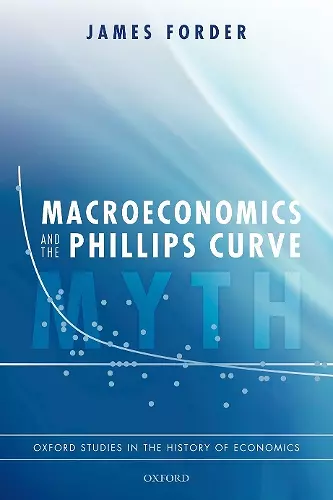Macroeconomics and the Phillips Curve Myth
Format:Paperback
Publisher:Oxford University Press
Published:22nd Feb '18
Currently unavailable, and unfortunately no date known when it will be back
This paperback is available in another edition too:
- Hardback£117.50(9780199683659)

This book reconsiders the role of the Phillips curve in macroeconomic analysis in the first twenty years following the famous work by A. W. H. Phillips, after whom it is named. It argues that the story conventionally told is entirely misleading. In that story, Phillips made a great breakthrough but his work led to a view that inflationary policy could be used systematically to maintain low unemployment, and that it was only after the work of Milton Friedman and Edmund Phelps about a decade after Phillips' that this view was rejected. On the contrary, a detailed analysis of the literature of the times shows that the idea of a negative relation between wage change and unemployment - supposedly Phillips' discovery - was commonplace in the 1950s, as were the arguments attributed to Friedman and Phelps by the conventional story. And, perhaps most importantly, there is scarcely any sign of the idea of the inflation-unemployment tradeoff promoting inflationary policy, either in the theoretical literature or in actual policymaking. The book demonstrates and identifies a number of main strands of the actual thinking of the 1950s, 1960s, and 1970s on the question of the determination of inflation and its relation to other variables. The result is not only a rejection of the Phillips curve story as it has been told, and a reassessment of the understanding of the economists of those years of macroeconomics, but also the construction of an alternative, and historically more authentic account, of the economic theory of those times. A notable outcome is that the economic theory of the time was not nearly so naïve as it has been portrayed.
This highly original book overturns decades of wrong thinking about the history of one of the central concepts in modern macroeconomics and provides an excellent starting point for rethinking the history of macroeconomics since the Second World War. * Professor Roger Backhouse, FBA, University of Birmingham and Erasmus University Rotterdam *
Over the last few years, James Forder has made a name for himself among historians of economics by writing a string of papers re-examining the Phillips curve literature...a brilliant and beautifully written essay, and a stimulating read. Its authors cleverness shines through on every page. Its scholarship is impeccable. * Professor Michel de Vroey, Université catholique de Louvain *
...the book is also a call to arms. A bogus story about Keynesian fools and Friedmanite heroes has long lent rhetorical support to the counter-revolution in macroeconomics. * Dr Michael Beggs, The University of Sydney *
After Forder's book no fair-minded observer will be able again to assert that the common story of the Phillips curve is what really happened. It is rare that a historical question is so decisively settled. * Professor Kevin Hoover, Duke University *
James Forder successfully convinces the reader of many points, which indeed should force the current state of the inflation-unemployment literature to treat the formation of the story more carefully ... Forder does an excellent job of highlighting Phillips' key contributions. * Sandeep Mazumder, EH.Net *
ISBN: 9780198819875
Dimensions: 234mm x 157mm x 18mm
Weight: 488g
320 pages